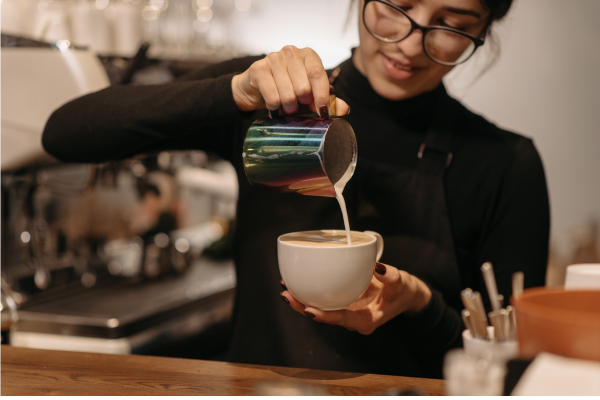For many, coffee is more than just a drink; it’s a passion. The desire to craft exceptional coffee at home is growing. This journey transforms a casual drinker into a true home barista. It requires more than just good beans.
Building the ultimate home barista setup involves selecting the right gear. Each piece plays a crucial role. From grinding to brewing, proper equipment elevates your coffee experience.
This guide will walk you through the essential tools. It will help you create a coffee station that rivals your favorite cafe.
Why Invest in a Home Barista Setup?
Making coffee at home offers unparalleled control. You can customize every variable. This allows you to fine-tune your brew to perfection. It caters precisely to your taste preferences.
It’s also a significant cost-saver over time. Daily cafe visits add up quickly. Brewing at home is far more economical. This allows you to invest in higher-quality beans and equipment.
The process itself is incredibly rewarding. There’s satisfaction in mastering new techniques. The ritual of brewing becomes a mindful start to your day. It deepens your appreciation for coffee.
Finally, a dedicated setup ensures freshness. You grind beans moments before brewing. This preserves delicate aromas and flavors. It simply isn’t possible with pre-ground coffee.
The Foundation: Quality Coffee Beans
Before any gear, you need excellent coffee beans. Even the best equipment can’t fix bad beans. Look for freshly roasted, whole beans. Always check the roast date, not just an expiry date.
Buy beans roasted within the last few weeks. Store them properly in an airtight, opaque container. Keep them away from light, heat, and moisture. This maintains their freshness and flavor.
Experiment with different origins and roasts. Each offers unique flavor profiles. Finding your favorite beans is part of the fun. They are the heart of your home barista setup.
The Most Crucial Tool: A Quality Coffee Grinder
A grinder is arguably the most important piece of gear. It unlocks the flavor potential of your beans. Grinding just before brewing is non-negotiable for superior taste.
Burr Grinders vs. Blade Grinders
Always choose a burr grinder. Blade grinders chop beans inconsistently. This leads to uneven extraction and poor flavor. Burr grinders mill beans uniformly, ensuring even extraction.
Burr grinders come in two main types: conical and flat. Both offer excellent consistency. Conical burrs are often quieter and produce less static. They are great for home use.
Manual vs. Electric Burr Grinders
Electric burr grinders offer convenience. They grind quickly at the touch of a button. Look for models with multiple grind settings. They should offer precise control for various brew methods.
Manual burr grinders are portable and often more affordable. They require arm power but offer precise control. They’re great for travel or smaller budgets. They provide a quiet, tactile experience.
Consider grind consistency above all else. This ensures optimal flavor extraction. A good grinder is an investment that pays dividends in every cup. It’s the first step to true home barista status.
Precision is Key: The Coffee Scale
For consistent, delicious coffee, you must measure accurately. Relying on scoops is inconsistent. Beans vary in density, so volume measurements are unreliable.
A digital coffee scale is essential. It measures both coffee grounds and water by weight. This ensures you use the correct ratio every time. Consistency is the hallmark of a great barista.
Look for a scale that measures in 0.1-gram increments. It should have a quick response time. A built-in timer is a bonus for pour-over brewing. It simplifies your brewing workflow.
Using a scale eliminates guesswork. It allows you to replicate successful brews precisely. It also helps you troubleshoot if a brew goes wrong. This tool is fundamental for quality control.
The Heating Element: A Good Kettle
Water quality and temperature are critical for brewing. Your kettle plays a significant role here. It’s not just about boiling water.
Temperature Control Kettles
An electric kettle with temperature control is highly recommended. Different brewing methods require specific water temperatures. Too hot, and you risk over-extraction and bitterness. Too cool, and you’ll get under-extraction and sourness.
Look for models that hold a precise temperature. They should have intuitive controls. Preset temperature options are a plus. This ensures your water is always at its ideal brewing point.
Gooseneck Kettles for Manual Brewing
For pour-over methods like Hario V60 or Chemex, a gooseneck kettle is essential. Its long, slender spout allows for precise water flow. You can control the pouring speed and saturation.
This control is crucial for even extraction. It helps you “bloom” the coffee effectively. It also allows for gentle, consistent pouring. This is vital for complex manual brewing techniques.
Whether electric or stovetop, a gooseneck kettle enhances manual brewing. It’s a small detail that makes a big difference. It gives you the precision of a professional barista.
Choosing Your Brewing Method: The Heart of the Setup
This is where your personal preference truly shines. There are numerous brewing methods. Each offers a unique flavor profile and experience.
Pour-Over Brewers (Hario V60, Chemex, Kalita Wave)
Pour-over methods offer clean, bright, and nuanced cups. They highlight the delicate flavors of specialty coffee. They require a bit more technique and patience.
- Hario V60: A cone-shaped dripper known for its fast flow. It produces a clean cup. It allows for a high degree of control over extraction.
- Chemex: A classic, elegant brewer. Its thicker filter produces an exceptionally clean cup. It has a slightly slower flow rate. It’s great for brewing larger batches.
- Kalita Wave: A flat-bottomed brewer with three holes. This provides a more even extraction. It’s often more forgiving for beginners.
These methods require paper filters. They also benefit greatly from a gooseneck kettle and a scale. They are perfect for those who enjoy the ritual.
Immersion Brewers (French Press, Aeropress)
Immersion brewers offer a full-bodied, rich cup. The coffee grounds steep completely in water. This extracts more oils and fines.
- French Press: Known for its rich, heavy-bodied coffee. It’s simple to use and great for a robust cup. It produces some sediment in the cup.
- Aeropress: Versatile and portable. It can brew espresso-style concentrates or full-bodied coffee. It’s quick and produces a clean cup with minimal sediment. It’s highly forgiving and consistent.
These methods are often more forgiving with grind size. They are great for beginners. They produce a flavorful, hearty brew. They are fantastic for daily use.
Espresso Machines (Manual, Semi-Automatic, Automatic)
For true espresso lovers, an espresso machine is essential. It uses pressurized hot water for a concentrated shot. This is the base for lattes, cappuccinos, and more.
- Manual Espresso Machines: Offer complete control over pressure. They require skill and practice. They provide an incredibly rewarding experience.
- Semi-Automatic Espresso Machines: Provide control over grind and dose. They automate the brewing pressure. They are popular for home enthusiasts.
- Automatic Espresso Machines (Bean-to-Cup): Grind beans and brew espresso at the touch of a button. They offer convenience but less control. They are great for quick, consistent drinks.
Pairing an espresso machine with a quality espresso-specific grinder is vital. It’s a significant investment. But it delivers cafe-quality drinks at home.
Water Quality: The Unsung Hero
Coffee is over 98% water. The quality of your water drastically impacts flavor. Tap water often contains chlorine or minerals. These can negatively affect your brew.
Invest in a water filter. A simple pitcher filter (like Brita or Pur) can make a difference. For serious enthusiasts, a reverse osmosis system with remineralization is ideal.
Avoid distilled water; it lacks minerals. Minerals are necessary for proper flavor extraction. Use filtered water that is clean and fresh. This simple step elevates your coffee.
Essential Accessories for Your Setup
Beyond the core brewing equipment, several accessories enhance your experience. They add convenience, precision, and enjoyment to your home barista routine.
Coffee Storage Containers
Proper storage maintains coffee freshness. Look for airtight, opaque containers. These protect beans from oxygen, light, and moisture. They prevent stale flavors from developing quickly.
Vacuum-sealed containers are excellent. They remove air, extending freshness. Always store whole beans; grind just before brewing. This ensures peak flavor.
Cleaning Supplies
Regular cleaning is vital for gear longevity and flavor. Coffee oils can build up. They become rancid over time. This imparts bitter, off-flavors to your brew.
- Grinder Brush/Cleaner: To remove loose grounds and oils from burrs. Specific cleaning tablets can also be used.
- Descaling Solution: For kettles and espresso machines. It removes mineral buildup from hard water. This maintains efficiency and prolongs life.
- Brewing Device Cleaners: Specific solutions for pour-over drippers or French presses. Regular rinsing and occasional deep cleaning are important.
- Microfiber Cloths: For wiping down surfaces and equipment. Keep them clean and dedicated to coffee gear.
A clean setup ensures every cup tastes fresh. It also protects your investment. Make cleaning a regular part of your coffee routine.
Tamper (for Espresso)
If you have an espresso machine, a good tamper is essential. It compresses the coffee grounds evenly in the portafilter. This creates consistent resistance for water flow.
A level, consistent tamp is crucial for good espresso. It prevents channeling. Look for a tamper that fits your portafilter perfectly. A heavy, ergonomic tamper is ideal.
Milk Frothing Pitcher and Thermometer (for Milk Drinks)
For lattes and cappuccinos, a stainless steel frothing pitcher is a must. It allows you to steam milk to perfection. Look for one with a spout for pouring latte art.
A milk thermometer helps achieve the ideal milk temperature. Too hot, and milk tastes scalded. Too cold, and it won’t be sweet. Aim for 140-150°F (60-65°C).
Coffee Mugs/Cups
The vessel you drink from matters. Choose mugs that fit your brewing style. Espresso cups are small and thick-walled. Pour-over can be enjoyed in various ceramic mugs.
Consider double-walled glass mugs. They keep coffee hot longer. They also allow you to appreciate the color of your brew. Enjoying coffee in a beautiful cup enhances the experience.
Building Your Setup: Step by Step
You don’t need to buy everything at once. Build your home barista setup gradually. Start with the most impactful upgrades.
- Prioritize the Grinder: This is the single most important investment for flavor.
- Add a Scale: For consistent measurement and reproducibility.
- Choose a Kettle: Temperature control is a game-changer for precision.
- Select Your Primary Brewer: Start with one method you enjoy. Master it.
- Invest in Quality Beans: Always buy fresh, whole beans from reputable roasters.
- Add Accessories: Gradually acquire storage, cleaning tools, and specialized items.
Enjoy the process of discovery. Experiment with different beans and techniques. Your home barista journey is personal. It’s about finding what brings you the most joy in every cup.
Considerations Finals
Creating the ultimate home barista setup is an exciting journey for any coffee lover. It’s a commitment to quality, precision, and the pure joy of crafting exceptional coffee.
Each piece of gear, from the foundational burr grinder to the precise temperature-controlled kettle, plays a vital role in elevating your daily ritual.
By thoughtfully selecting your equipment, understanding its purpose, and dedicating time to practice, you’ll unlock flavors you never thought possible at home.
This isn’t just about owning tools; it’s about building a coffee sanctuary tailored to your tastes, fostering a deeper appreciation for every aromatic sip, and transforming your home into the best coffee shop in town. Cheers to your brewing adventures!

